Sustainable Construction: Energy Efficient Technologies and Products
VerifiedAdded on 2023/01/12
|11
|3139
|99
AI Summary
This report explores the concept of sustainable construction and the use of energy efficient technologies and products. It discusses the impact of human behavior on the consumption of these technologies and explores measures to enhance energy efficiency and reduce carbon footprint. The report also assesses the sustainable technologies already present in your own home.
Contribute Materials
Your contribution can guide someone’s learning journey. Share your
documents today.
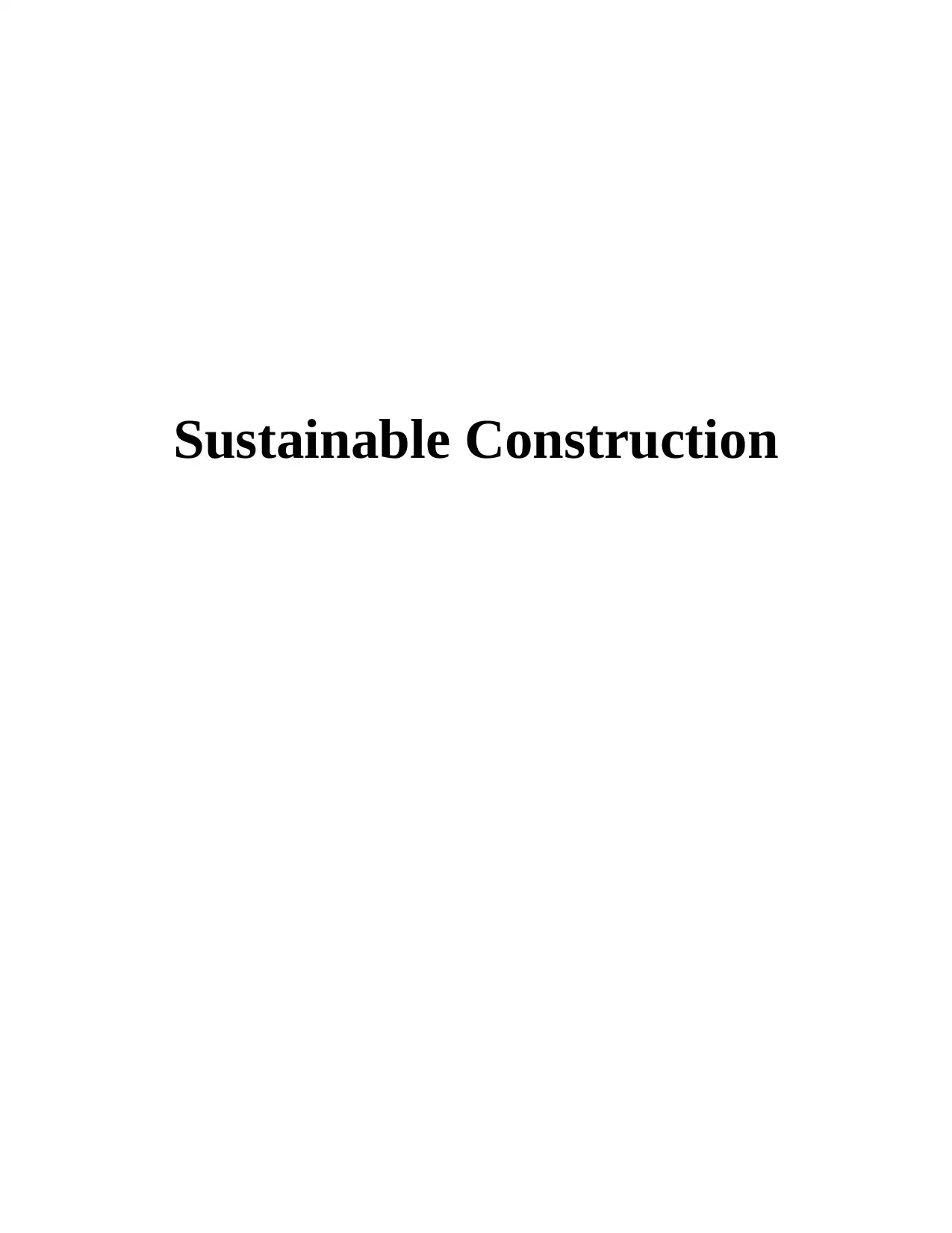
Sustainable Construction
Secure Best Marks with AI Grader
Need help grading? Try our AI Grader for instant feedback on your assignments.
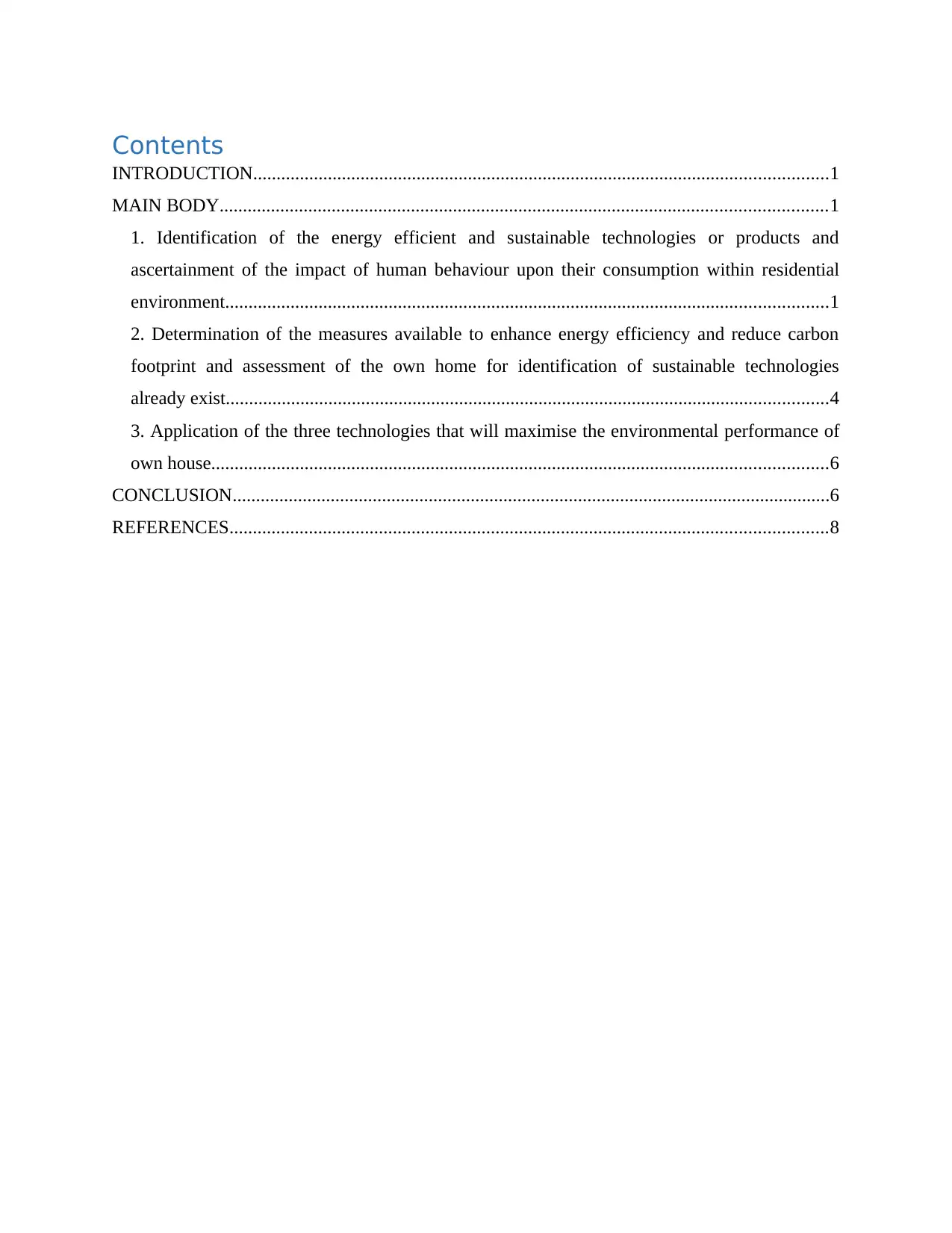
Contents
INTRODUCTION...........................................................................................................................1
MAIN BODY..................................................................................................................................1
1. Identification of the energy efficient and sustainable technologies or products and
ascertainment of the impact of human behaviour upon their consumption within residential
environment.................................................................................................................................1
2. Determination of the measures available to enhance energy efficiency and reduce carbon
footprint and assessment of the own home for identification of sustainable technologies
already exist.................................................................................................................................4
3. Application of the three technologies that will maximise the environmental performance of
own house....................................................................................................................................6
CONCLUSION................................................................................................................................6
REFERENCES................................................................................................................................8
INTRODUCTION...........................................................................................................................1
MAIN BODY..................................................................................................................................1
1. Identification of the energy efficient and sustainable technologies or products and
ascertainment of the impact of human behaviour upon their consumption within residential
environment.................................................................................................................................1
2. Determination of the measures available to enhance energy efficiency and reduce carbon
footprint and assessment of the own home for identification of sustainable technologies
already exist.................................................................................................................................4
3. Application of the three technologies that will maximise the environmental performance of
own house....................................................................................................................................6
CONCLUSION................................................................................................................................6
REFERENCES................................................................................................................................8

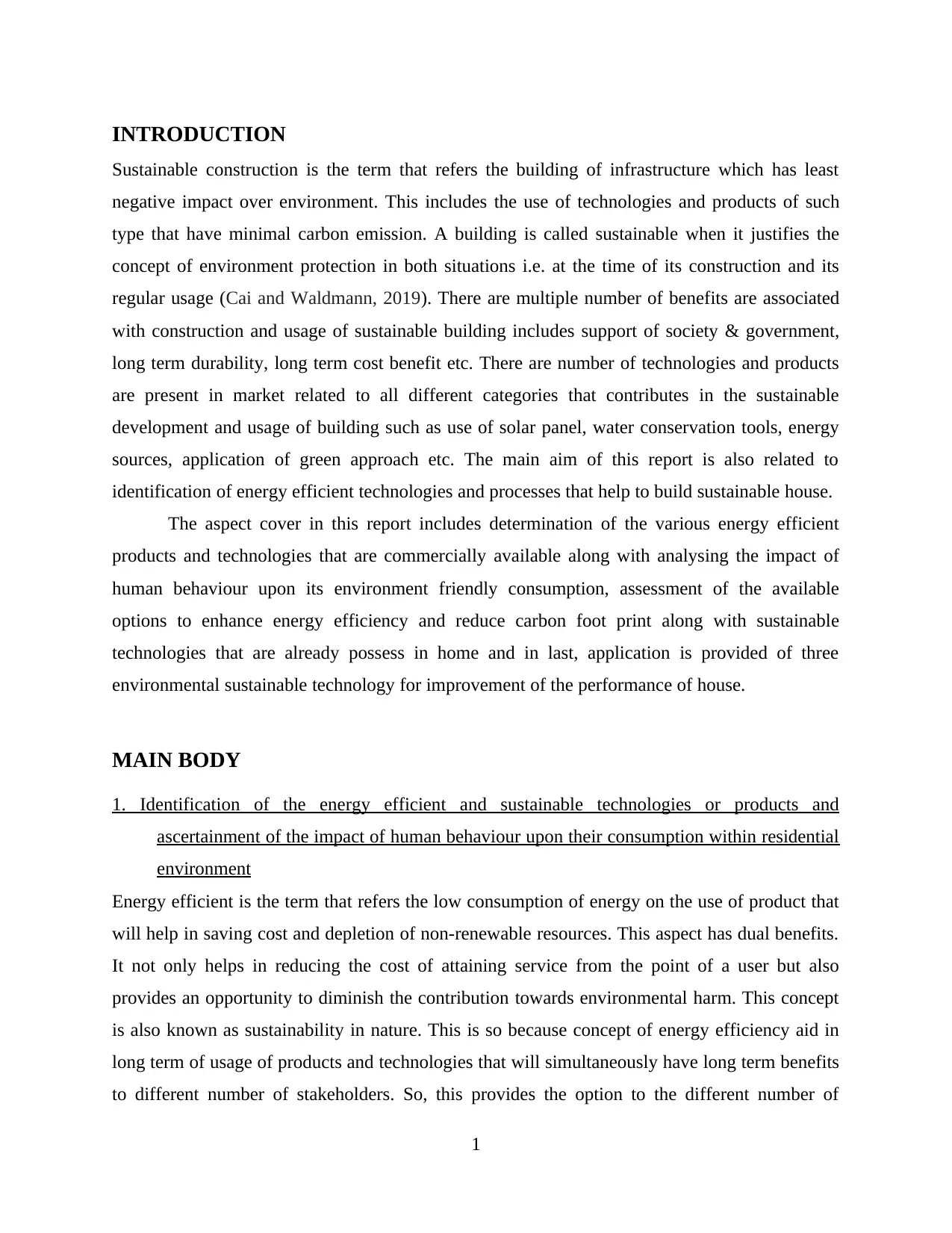
INTRODUCTION
Sustainable construction is the term that refers the building of infrastructure which has least
negative impact over environment. This includes the use of technologies and products of such
type that have minimal carbon emission. A building is called sustainable when it justifies the
concept of environment protection in both situations i.e. at the time of its construction and its
regular usage (Cai and Waldmann, 2019). There are multiple number of benefits are associated
with construction and usage of sustainable building includes support of society & government,
long term durability, long term cost benefit etc. There are number of technologies and products
are present in market related to all different categories that contributes in the sustainable
development and usage of building such as use of solar panel, water conservation tools, energy
sources, application of green approach etc. The main aim of this report is also related to
identification of energy efficient technologies and processes that help to build sustainable house.
The aspect cover in this report includes determination of the various energy efficient
products and technologies that are commercially available along with analysing the impact of
human behaviour upon its environment friendly consumption, assessment of the available
options to enhance energy efficiency and reduce carbon foot print along with sustainable
technologies that are already possess in home and in last, application is provided of three
environmental sustainable technology for improvement of the performance of house.
MAIN BODY
1. Identification of the energy efficient and sustainable technologies or products and
ascertainment of the impact of human behaviour upon their consumption within residential
environment
Energy efficient is the term that refers the low consumption of energy on the use of product that
will help in saving cost and depletion of non-renewable resources. This aspect has dual benefits.
It not only helps in reducing the cost of attaining service from the point of a user but also
provides an opportunity to diminish the contribution towards environmental harm. This concept
is also known as sustainability in nature. This is so because concept of energy efficiency aid in
long term of usage of products and technologies that will simultaneously have long term benefits
to different number of stakeholders. So, this provides the option to the different number of
1
Sustainable construction is the term that refers the building of infrastructure which has least
negative impact over environment. This includes the use of technologies and products of such
type that have minimal carbon emission. A building is called sustainable when it justifies the
concept of environment protection in both situations i.e. at the time of its construction and its
regular usage (Cai and Waldmann, 2019). There are multiple number of benefits are associated
with construction and usage of sustainable building includes support of society & government,
long term durability, long term cost benefit etc. There are number of technologies and products
are present in market related to all different categories that contributes in the sustainable
development and usage of building such as use of solar panel, water conservation tools, energy
sources, application of green approach etc. The main aim of this report is also related to
identification of energy efficient technologies and processes that help to build sustainable house.
The aspect cover in this report includes determination of the various energy efficient
products and technologies that are commercially available along with analysing the impact of
human behaviour upon its environment friendly consumption, assessment of the available
options to enhance energy efficiency and reduce carbon foot print along with sustainable
technologies that are already possess in home and in last, application is provided of three
environmental sustainable technology for improvement of the performance of house.
MAIN BODY
1. Identification of the energy efficient and sustainable technologies or products and
ascertainment of the impact of human behaviour upon their consumption within residential
environment
Energy efficient is the term that refers the low consumption of energy on the use of product that
will help in saving cost and depletion of non-renewable resources. This aspect has dual benefits.
It not only helps in reducing the cost of attaining service from the point of a user but also
provides an opportunity to diminish the contribution towards environmental harm. This concept
is also known as sustainability in nature. This is so because concept of energy efficiency aid in
long term of usage of products and technologies that will simultaneously have long term benefits
to different number of stakeholders. So, this provides the option to the different number of
1
Secure Best Marks with AI Grader
Need help grading? Try our AI Grader for instant feedback on your assignments.
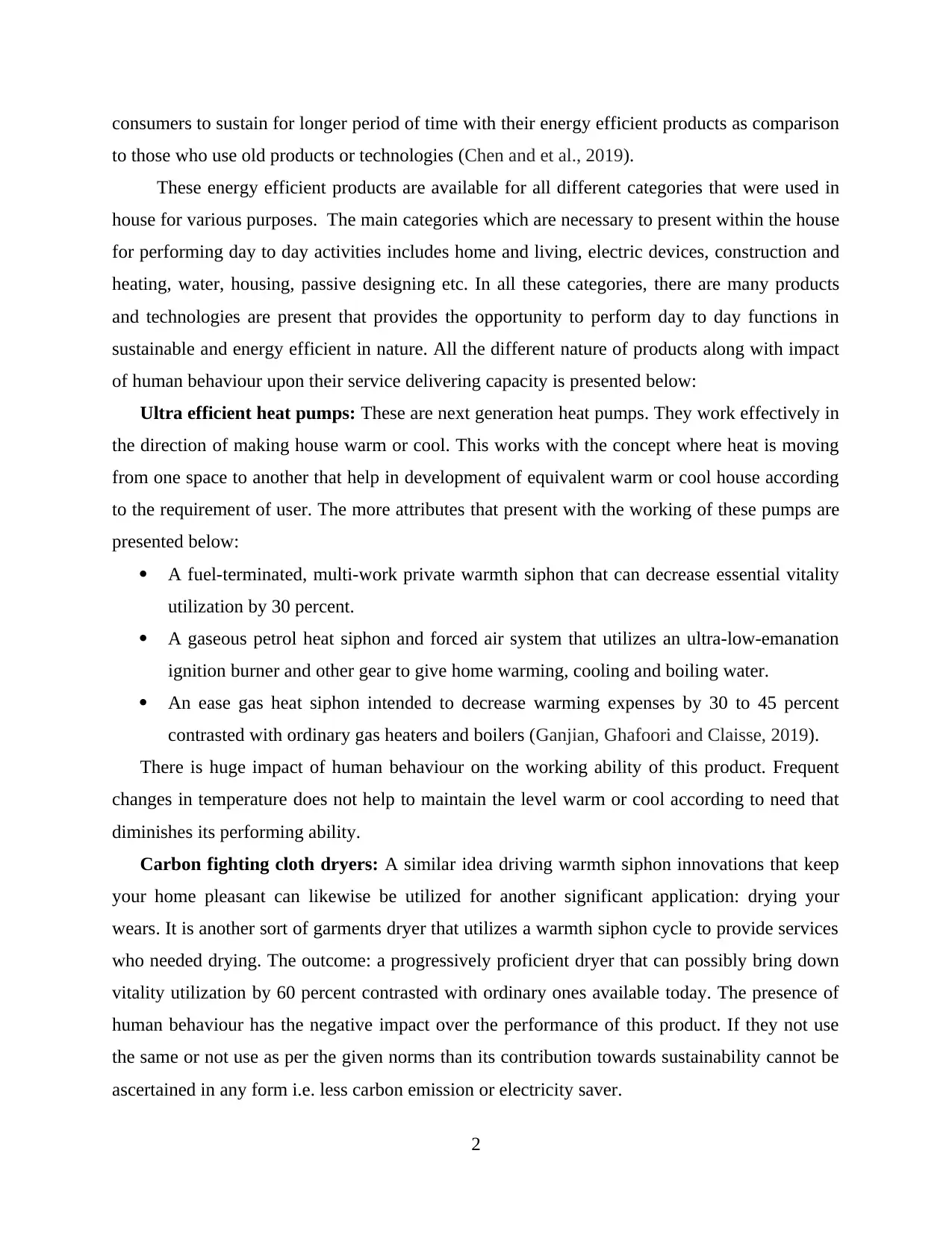
consumers to sustain for longer period of time with their energy efficient products as comparison
to those who use old products or technologies (Chen and et al., 2019).
These energy efficient products are available for all different categories that were used in
house for various purposes. The main categories which are necessary to present within the house
for performing day to day activities includes home and living, electric devices, construction and
heating, water, housing, passive designing etc. In all these categories, there are many products
and technologies are present that provides the opportunity to perform day to day functions in
sustainable and energy efficient in nature. All the different nature of products along with impact
of human behaviour upon their service delivering capacity is presented below:
Ultra efficient heat pumps: These are next generation heat pumps. They work effectively in
the direction of making house warm or cool. This works with the concept where heat is moving
from one space to another that help in development of equivalent warm or cool house according
to the requirement of user. The more attributes that present with the working of these pumps are
presented below:
A fuel-terminated, multi-work private warmth siphon that can decrease essential vitality
utilization by 30 percent.
A gaseous petrol heat siphon and forced air system that utilizes an ultra-low-emanation
ignition burner and other gear to give home warming, cooling and boiling water.
An ease gas heat siphon intended to decrease warming expenses by 30 to 45 percent
contrasted with ordinary gas heaters and boilers (Ganjian, Ghafoori and Claisse, 2019).
There is huge impact of human behaviour on the working ability of this product. Frequent
changes in temperature does not help to maintain the level warm or cool according to need that
diminishes its performing ability.
Carbon fighting cloth dryers: A similar idea driving warmth siphon innovations that keep
your home pleasant can likewise be utilized for another significant application: drying your
wears. It is another sort of garments dryer that utilizes a warmth siphon cycle to provide services
who needed drying. The outcome: a progressively proficient dryer that can possibly bring down
vitality utilization by 60 percent contrasted with ordinary ones available today. The presence of
human behaviour has the negative impact over the performance of this product. If they not use
the same or not use as per the given norms than its contribution towards sustainability cannot be
ascertained in any form i.e. less carbon emission or electricity saver.
2
to those who use old products or technologies (Chen and et al., 2019).
These energy efficient products are available for all different categories that were used in
house for various purposes. The main categories which are necessary to present within the house
for performing day to day activities includes home and living, electric devices, construction and
heating, water, housing, passive designing etc. In all these categories, there are many products
and technologies are present that provides the opportunity to perform day to day functions in
sustainable and energy efficient in nature. All the different nature of products along with impact
of human behaviour upon their service delivering capacity is presented below:
Ultra efficient heat pumps: These are next generation heat pumps. They work effectively in
the direction of making house warm or cool. This works with the concept where heat is moving
from one space to another that help in development of equivalent warm or cool house according
to the requirement of user. The more attributes that present with the working of these pumps are
presented below:
A fuel-terminated, multi-work private warmth siphon that can decrease essential vitality
utilization by 30 percent.
A gaseous petrol heat siphon and forced air system that utilizes an ultra-low-emanation
ignition burner and other gear to give home warming, cooling and boiling water.
An ease gas heat siphon intended to decrease warming expenses by 30 to 45 percent
contrasted with ordinary gas heaters and boilers (Ganjian, Ghafoori and Claisse, 2019).
There is huge impact of human behaviour on the working ability of this product. Frequent
changes in temperature does not help to maintain the level warm or cool according to need that
diminishes its performing ability.
Carbon fighting cloth dryers: A similar idea driving warmth siphon innovations that keep
your home pleasant can likewise be utilized for another significant application: drying your
wears. It is another sort of garments dryer that utilizes a warmth siphon cycle to provide services
who needed drying. The outcome: a progressively proficient dryer that can possibly bring down
vitality utilization by 60 percent contrasted with ordinary ones available today. The presence of
human behaviour has the negative impact over the performance of this product. If they not use
the same or not use as per the given norms than its contribution towards sustainability cannot be
ascertained in any form i.e. less carbon emission or electricity saver.
2
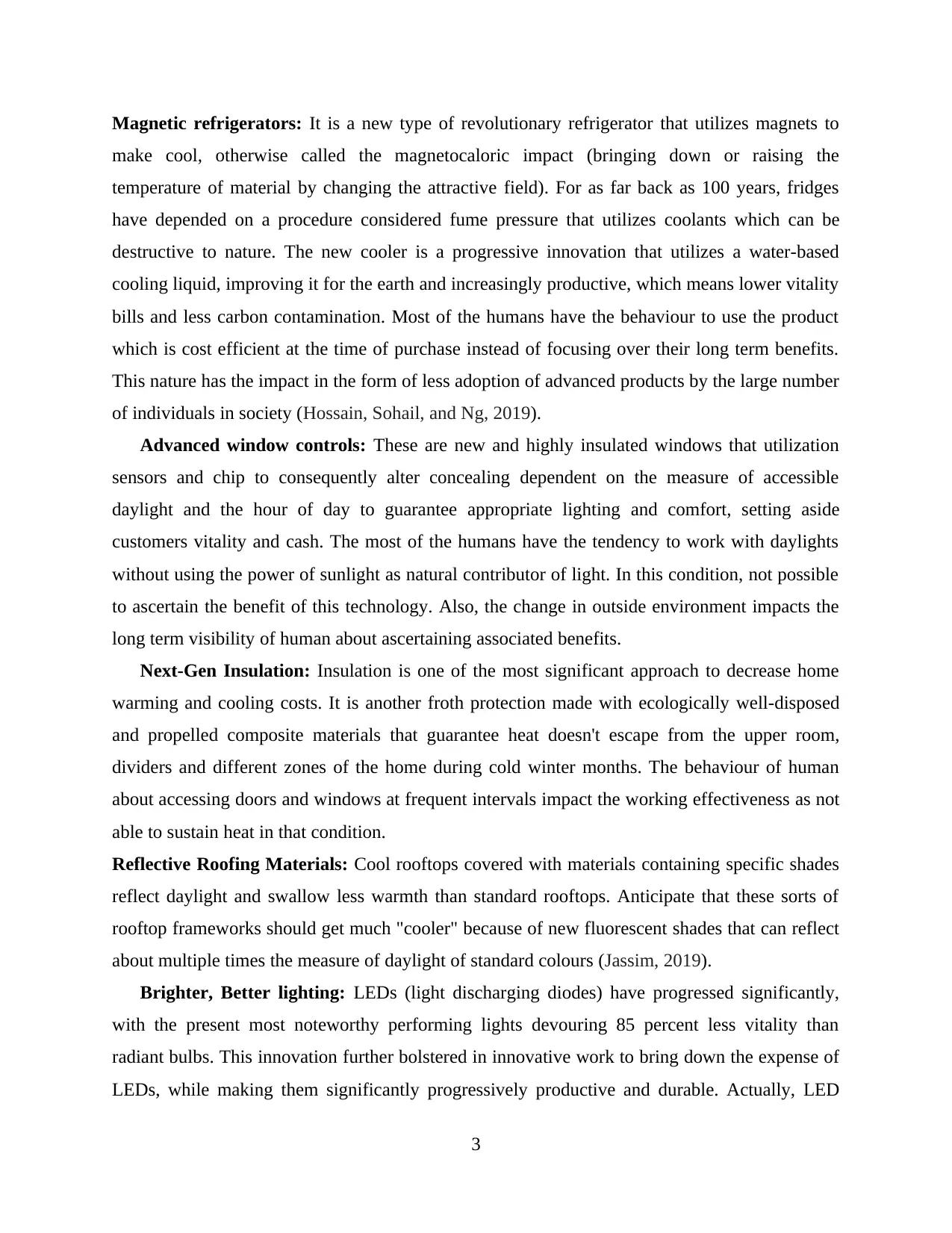
Magnetic refrigerators: It is a new type of revolutionary refrigerator that utilizes magnets to
make cool, otherwise called the magnetocaloric impact (bringing down or raising the
temperature of material by changing the attractive field). For as far back as 100 years, fridges
have depended on a procedure considered fume pressure that utilizes coolants which can be
destructive to nature. The new cooler is a progressive innovation that utilizes a water-based
cooling liquid, improving it for the earth and increasingly productive, which means lower vitality
bills and less carbon contamination. Most of the humans have the behaviour to use the product
which is cost efficient at the time of purchase instead of focusing over their long term benefits.
This nature has the impact in the form of less adoption of advanced products by the large number
of individuals in society (Hossain, Sohail, and Ng, 2019).
Advanced window controls: These are new and highly insulated windows that utilization
sensors and chip to consequently alter concealing dependent on the measure of accessible
daylight and the hour of day to guarantee appropriate lighting and comfort, setting aside
customers vitality and cash. The most of the humans have the tendency to work with daylights
without using the power of sunlight as natural contributor of light. In this condition, not possible
to ascertain the benefit of this technology. Also, the change in outside environment impacts the
long term visibility of human about ascertaining associated benefits.
Next-Gen Insulation: Insulation is one of the most significant approach to decrease home
warming and cooling costs. It is another froth protection made with ecologically well-disposed
and propelled composite materials that guarantee heat doesn't escape from the upper room,
dividers and different zones of the home during cold winter months. The behaviour of human
about accessing doors and windows at frequent intervals impact the working effectiveness as not
able to sustain heat in that condition.
Reflective Roofing Materials: Cool rooftops covered with materials containing specific shades
reflect daylight and swallow less warmth than standard rooftops. Anticipate that these sorts of
rooftop frameworks should get much "cooler" because of new fluorescent shades that can reflect
about multiple times the measure of daylight of standard colours (Jassim, 2019).
Brighter, Better lighting: LEDs (light discharging diodes) have progressed significantly,
with the present most noteworthy performing lights devouring 85 percent less vitality than
radiant bulbs. This innovation further bolstered in innovative work to bring down the expense of
LEDs, while making them significantly progressively productive and durable. Actually, LED
3
make cool, otherwise called the magnetocaloric impact (bringing down or raising the
temperature of material by changing the attractive field). For as far back as 100 years, fridges
have depended on a procedure considered fume pressure that utilizes coolants which can be
destructive to nature. The new cooler is a progressive innovation that utilizes a water-based
cooling liquid, improving it for the earth and increasingly productive, which means lower vitality
bills and less carbon contamination. Most of the humans have the behaviour to use the product
which is cost efficient at the time of purchase instead of focusing over their long term benefits.
This nature has the impact in the form of less adoption of advanced products by the large number
of individuals in society (Hossain, Sohail, and Ng, 2019).
Advanced window controls: These are new and highly insulated windows that utilization
sensors and chip to consequently alter concealing dependent on the measure of accessible
daylight and the hour of day to guarantee appropriate lighting and comfort, setting aside
customers vitality and cash. The most of the humans have the tendency to work with daylights
without using the power of sunlight as natural contributor of light. In this condition, not possible
to ascertain the benefit of this technology. Also, the change in outside environment impacts the
long term visibility of human about ascertaining associated benefits.
Next-Gen Insulation: Insulation is one of the most significant approach to decrease home
warming and cooling costs. It is another froth protection made with ecologically well-disposed
and propelled composite materials that guarantee heat doesn't escape from the upper room,
dividers and different zones of the home during cold winter months. The behaviour of human
about accessing doors and windows at frequent intervals impact the working effectiveness as not
able to sustain heat in that condition.
Reflective Roofing Materials: Cool rooftops covered with materials containing specific shades
reflect daylight and swallow less warmth than standard rooftops. Anticipate that these sorts of
rooftop frameworks should get much "cooler" because of new fluorescent shades that can reflect
about multiple times the measure of daylight of standard colours (Jassim, 2019).
Brighter, Better lighting: LEDs (light discharging diodes) have progressed significantly,
with the present most noteworthy performing lights devouring 85 percent less vitality than
radiant bulbs. This innovation further bolstered in innovative work to bring down the expense of
LEDs, while making them significantly progressively productive and durable. Actually, LED
3
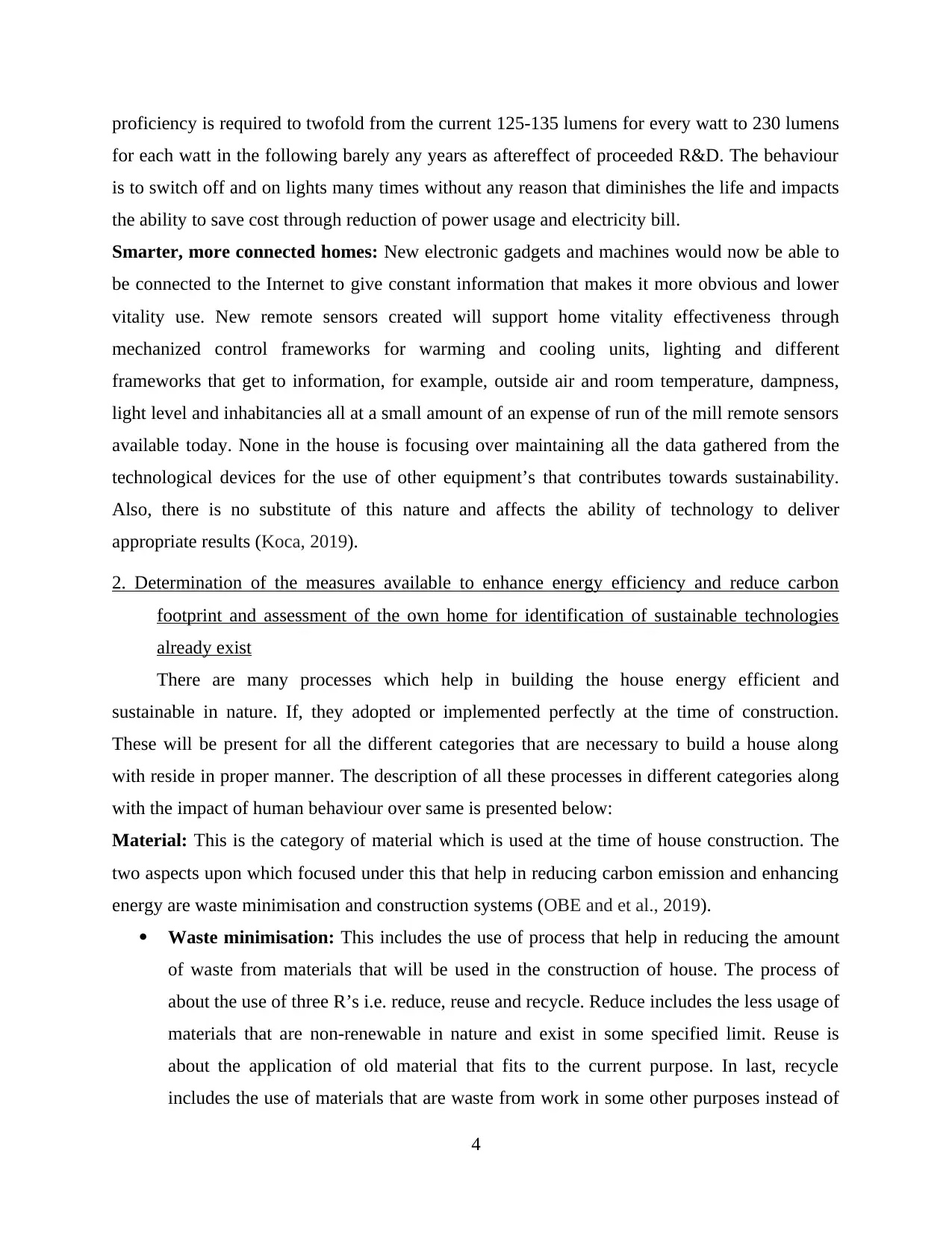
proficiency is required to twofold from the current 125-135 lumens for every watt to 230 lumens
for each watt in the following barely any years as aftereffect of proceeded R&D. The behaviour
is to switch off and on lights many times without any reason that diminishes the life and impacts
the ability to save cost through reduction of power usage and electricity bill.
Smarter, more connected homes: New electronic gadgets and machines would now be able to
be connected to the Internet to give constant information that makes it more obvious and lower
vitality use. New remote sensors created will support home vitality effectiveness through
mechanized control frameworks for warming and cooling units, lighting and different
frameworks that get to information, for example, outside air and room temperature, dampness,
light level and inhabitancies all at a small amount of an expense of run of the mill remote sensors
available today. None in the house is focusing over maintaining all the data gathered from the
technological devices for the use of other equipment’s that contributes towards sustainability.
Also, there is no substitute of this nature and affects the ability of technology to deliver
appropriate results (Koca, 2019).
2. Determination of the measures available to enhance energy efficiency and reduce carbon
footprint and assessment of the own home for identification of sustainable technologies
already exist
There are many processes which help in building the house energy efficient and
sustainable in nature. If, they adopted or implemented perfectly at the time of construction.
These will be present for all the different categories that are necessary to build a house along
with reside in proper manner. The description of all these processes in different categories along
with the impact of human behaviour over same is presented below:
Material: This is the category of material which is used at the time of house construction. The
two aspects upon which focused under this that help in reducing carbon emission and enhancing
energy are waste minimisation and construction systems (OBE and et al., 2019).
Waste minimisation: This includes the use of process that help in reducing the amount
of waste from materials that will be used in the construction of house. The process of
about the use of three R’s i.e. reduce, reuse and recycle. Reduce includes the less usage of
materials that are non-renewable in nature and exist in some specified limit. Reuse is
about the application of old material that fits to the current purpose. In last, recycle
includes the use of materials that are waste from work in some other purposes instead of
4
for each watt in the following barely any years as aftereffect of proceeded R&D. The behaviour
is to switch off and on lights many times without any reason that diminishes the life and impacts
the ability to save cost through reduction of power usage and electricity bill.
Smarter, more connected homes: New electronic gadgets and machines would now be able to
be connected to the Internet to give constant information that makes it more obvious and lower
vitality use. New remote sensors created will support home vitality effectiveness through
mechanized control frameworks for warming and cooling units, lighting and different
frameworks that get to information, for example, outside air and room temperature, dampness,
light level and inhabitancies all at a small amount of an expense of run of the mill remote sensors
available today. None in the house is focusing over maintaining all the data gathered from the
technological devices for the use of other equipment’s that contributes towards sustainability.
Also, there is no substitute of this nature and affects the ability of technology to deliver
appropriate results (Koca, 2019).
2. Determination of the measures available to enhance energy efficiency and reduce carbon
footprint and assessment of the own home for identification of sustainable technologies
already exist
There are many processes which help in building the house energy efficient and
sustainable in nature. If, they adopted or implemented perfectly at the time of construction.
These will be present for all the different categories that are necessary to build a house along
with reside in proper manner. The description of all these processes in different categories along
with the impact of human behaviour over same is presented below:
Material: This is the category of material which is used at the time of house construction. The
two aspects upon which focused under this that help in reducing carbon emission and enhancing
energy are waste minimisation and construction systems (OBE and et al., 2019).
Waste minimisation: This includes the use of process that help in reducing the amount
of waste from materials that will be used in the construction of house. The process of
about the use of three R’s i.e. reduce, reuse and recycle. Reduce includes the less usage of
materials that are non-renewable in nature and exist in some specified limit. Reuse is
about the application of old material that fits to the current purpose. In last, recycle
includes the use of materials that are waste from work in some other purposes instead of
4
Paraphrase This Document
Need a fresh take? Get an instant paraphrase of this document with our AI Paraphraser
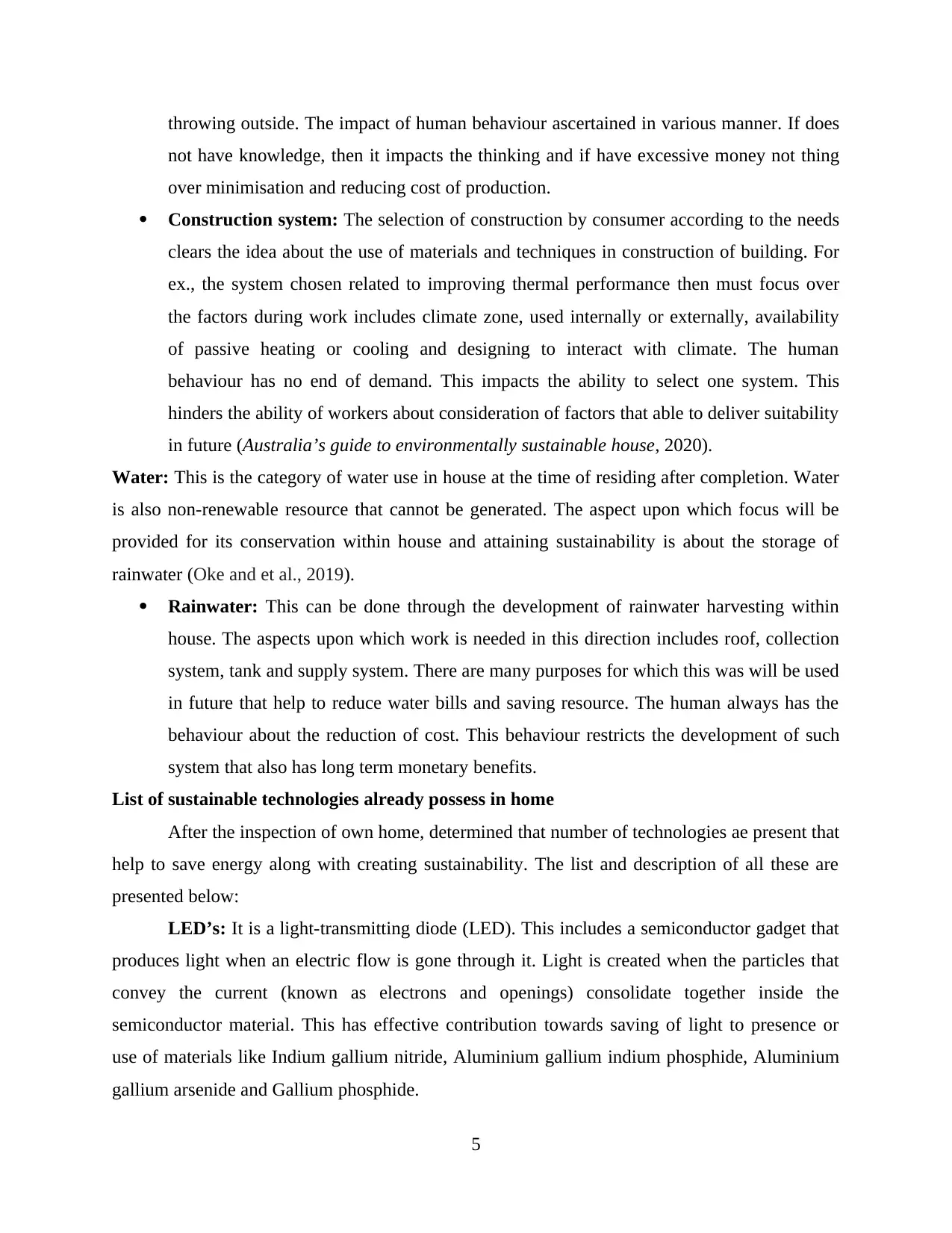
throwing outside. The impact of human behaviour ascertained in various manner. If does
not have knowledge, then it impacts the thinking and if have excessive money not thing
over minimisation and reducing cost of production.
Construction system: The selection of construction by consumer according to the needs
clears the idea about the use of materials and techniques in construction of building. For
ex., the system chosen related to improving thermal performance then must focus over
the factors during work includes climate zone, used internally or externally, availability
of passive heating or cooling and designing to interact with climate. The human
behaviour has no end of demand. This impacts the ability to select one system. This
hinders the ability of workers about consideration of factors that able to deliver suitability
in future (Australia’s guide to environmentally sustainable house, 2020).
Water: This is the category of water use in house at the time of residing after completion. Water
is also non-renewable resource that cannot be generated. The aspect upon which focus will be
provided for its conservation within house and attaining sustainability is about the storage of
rainwater (Oke and et al., 2019).
Rainwater: This can be done through the development of rainwater harvesting within
house. The aspects upon which work is needed in this direction includes roof, collection
system, tank and supply system. There are many purposes for which this was will be used
in future that help to reduce water bills and saving resource. The human always has the
behaviour about the reduction of cost. This behaviour restricts the development of such
system that also has long term monetary benefits.
List of sustainable technologies already possess in home
After the inspection of own home, determined that number of technologies ae present that
help to save energy along with creating sustainability. The list and description of all these are
presented below:
LED’s: It is a light-transmitting diode (LED). This includes a semiconductor gadget that
produces light when an electric flow is gone through it. Light is created when the particles that
convey the current (known as electrons and openings) consolidate together inside the
semiconductor material. This has effective contribution towards saving of light to presence or
use of materials like Indium gallium nitride, Aluminium gallium indium phosphide, Aluminium
gallium arsenide and Gallium phosphide.
5
not have knowledge, then it impacts the thinking and if have excessive money not thing
over minimisation and reducing cost of production.
Construction system: The selection of construction by consumer according to the needs
clears the idea about the use of materials and techniques in construction of building. For
ex., the system chosen related to improving thermal performance then must focus over
the factors during work includes climate zone, used internally or externally, availability
of passive heating or cooling and designing to interact with climate. The human
behaviour has no end of demand. This impacts the ability to select one system. This
hinders the ability of workers about consideration of factors that able to deliver suitability
in future (Australia’s guide to environmentally sustainable house, 2020).
Water: This is the category of water use in house at the time of residing after completion. Water
is also non-renewable resource that cannot be generated. The aspect upon which focus will be
provided for its conservation within house and attaining sustainability is about the storage of
rainwater (Oke and et al., 2019).
Rainwater: This can be done through the development of rainwater harvesting within
house. The aspects upon which work is needed in this direction includes roof, collection
system, tank and supply system. There are many purposes for which this was will be used
in future that help to reduce water bills and saving resource. The human always has the
behaviour about the reduction of cost. This behaviour restricts the development of such
system that also has long term monetary benefits.
List of sustainable technologies already possess in home
After the inspection of own home, determined that number of technologies ae present that
help to save energy along with creating sustainability. The list and description of all these are
presented below:
LED’s: It is a light-transmitting diode (LED). This includes a semiconductor gadget that
produces light when an electric flow is gone through it. Light is created when the particles that
convey the current (known as electrons and openings) consolidate together inside the
semiconductor material. This has effective contribution towards saving of light to presence or
use of materials like Indium gallium nitride, Aluminium gallium indium phosphide, Aluminium
gallium arsenide and Gallium phosphide.
5
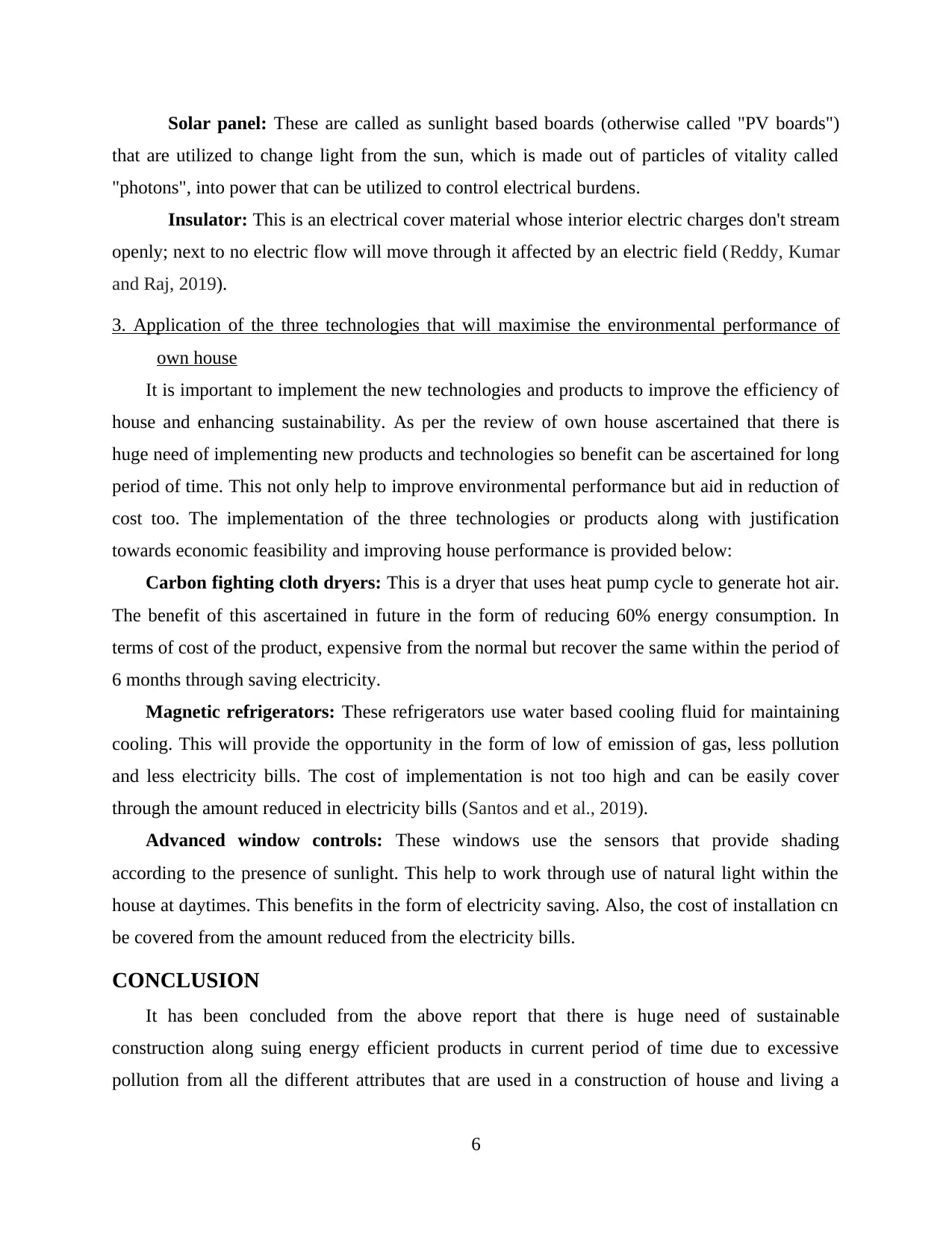
Solar panel: These are called as sunlight based boards (otherwise called "PV boards")
that are utilized to change light from the sun, which is made out of particles of vitality called
"photons", into power that can be utilized to control electrical burdens.
Insulator: This is an electrical cover material whose interior electric charges don't stream
openly; next to no electric flow will move through it affected by an electric field (Reddy, Kumar
and Raj, 2019).
3. Application of the three technologies that will maximise the environmental performance of
own house
It is important to implement the new technologies and products to improve the efficiency of
house and enhancing sustainability. As per the review of own house ascertained that there is
huge need of implementing new products and technologies so benefit can be ascertained for long
period of time. This not only help to improve environmental performance but aid in reduction of
cost too. The implementation of the three technologies or products along with justification
towards economic feasibility and improving house performance is provided below:
Carbon fighting cloth dryers: This is a dryer that uses heat pump cycle to generate hot air.
The benefit of this ascertained in future in the form of reducing 60% energy consumption. In
terms of cost of the product, expensive from the normal but recover the same within the period of
6 months through saving electricity.
Magnetic refrigerators: These refrigerators use water based cooling fluid for maintaining
cooling. This will provide the opportunity in the form of low of emission of gas, less pollution
and less electricity bills. The cost of implementation is not too high and can be easily cover
through the amount reduced in electricity bills (Santos and et al., 2019).
Advanced window controls: These windows use the sensors that provide shading
according to the presence of sunlight. This help to work through use of natural light within the
house at daytimes. This benefits in the form of electricity saving. Also, the cost of installation cn
be covered from the amount reduced from the electricity bills.
CONCLUSION
It has been concluded from the above report that there is huge need of sustainable
construction along suing energy efficient products in current period of time due to excessive
pollution from all the different attributes that are used in a construction of house and living a
6
that are utilized to change light from the sun, which is made out of particles of vitality called
"photons", into power that can be utilized to control electrical burdens.
Insulator: This is an electrical cover material whose interior electric charges don't stream
openly; next to no electric flow will move through it affected by an electric field (Reddy, Kumar
and Raj, 2019).
3. Application of the three technologies that will maximise the environmental performance of
own house
It is important to implement the new technologies and products to improve the efficiency of
house and enhancing sustainability. As per the review of own house ascertained that there is
huge need of implementing new products and technologies so benefit can be ascertained for long
period of time. This not only help to improve environmental performance but aid in reduction of
cost too. The implementation of the three technologies or products along with justification
towards economic feasibility and improving house performance is provided below:
Carbon fighting cloth dryers: This is a dryer that uses heat pump cycle to generate hot air.
The benefit of this ascertained in future in the form of reducing 60% energy consumption. In
terms of cost of the product, expensive from the normal but recover the same within the period of
6 months through saving electricity.
Magnetic refrigerators: These refrigerators use water based cooling fluid for maintaining
cooling. This will provide the opportunity in the form of low of emission of gas, less pollution
and less electricity bills. The cost of implementation is not too high and can be easily cover
through the amount reduced in electricity bills (Santos and et al., 2019).
Advanced window controls: These windows use the sensors that provide shading
according to the presence of sunlight. This help to work through use of natural light within the
house at daytimes. This benefits in the form of electricity saving. Also, the cost of installation cn
be covered from the amount reduced from the electricity bills.
CONCLUSION
It has been concluded from the above report that there is huge need of sustainable
construction along suing energy efficient products in current period of time due to excessive
pollution from all the different attributes that are used in a construction of house and living a
6

normal life. There are many processes that will help to develop sustainable building includes
adoption of techniques related to waste minimisation, effective construction systems etc. There
are many products are also present in market that work in direction of reducing energy
consumption like LED’s.
7
adoption of techniques related to waste minimisation, effective construction systems etc. There
are many products are also present in market that work in direction of reducing energy
consumption like LED’s.
7
Secure Best Marks with AI Grader
Need help grading? Try our AI Grader for instant feedback on your assignments.
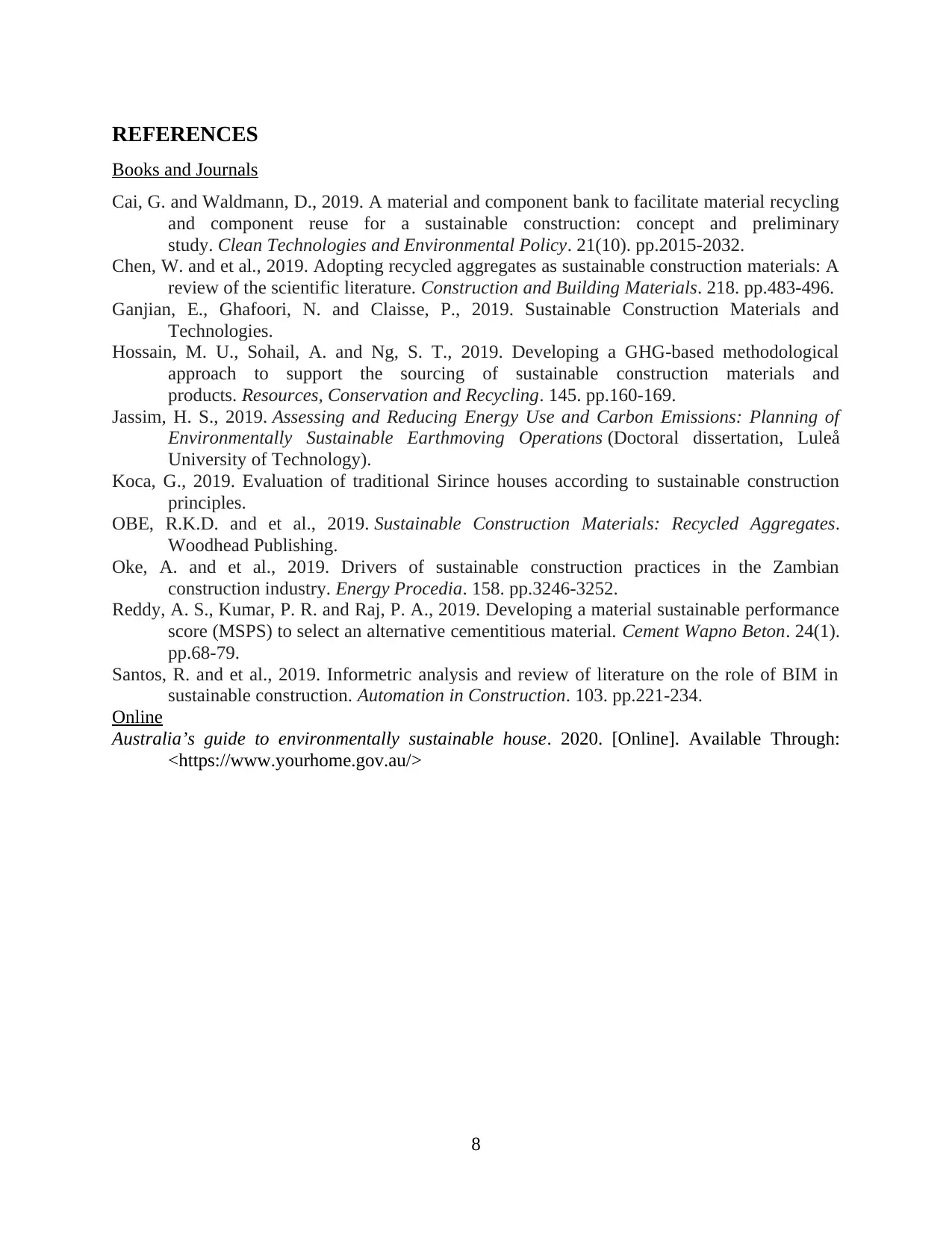
REFERENCES
Books and Journals
Cai, G. and Waldmann, D., 2019. A material and component bank to facilitate material recycling
and component reuse for a sustainable construction: concept and preliminary
study. Clean Technologies and Environmental Policy. 21(10). pp.2015-2032.
Chen, W. and et al., 2019. Adopting recycled aggregates as sustainable construction materials: A
review of the scientific literature. Construction and Building Materials. 218. pp.483-496.
Ganjian, E., Ghafoori, N. and Claisse, P., 2019. Sustainable Construction Materials and
Technologies.
Hossain, M. U., Sohail, A. and Ng, S. T., 2019. Developing a GHG-based methodological
approach to support the sourcing of sustainable construction materials and
products. Resources, Conservation and Recycling. 145. pp.160-169.
Jassim, H. S., 2019. Assessing and Reducing Energy Use and Carbon Emissions: Planning of
Environmentally Sustainable Earthmoving Operations (Doctoral dissertation, Luleå
University of Technology).
Koca, G., 2019. Evaluation of traditional Sirince houses according to sustainable construction
principles.
OBE, R.K.D. and et al., 2019. Sustainable Construction Materials: Recycled Aggregates.
Woodhead Publishing.
Oke, A. and et al., 2019. Drivers of sustainable construction practices in the Zambian
construction industry. Energy Procedia. 158. pp.3246-3252.
Reddy, A. S., Kumar, P. R. and Raj, P. A., 2019. Developing a material sustainable performance
score (MSPS) to select an alternative cementitious material. Cement Wapno Beton. 24(1).
pp.68-79.
Santos, R. and et al., 2019. Informetric analysis and review of literature on the role of BIM in
sustainable construction. Automation in Construction. 103. pp.221-234.
Online
Australia’s guide to environmentally sustainable house. 2020. [Online]. Available Through:
<https://www.yourhome.gov.au/>
8
Books and Journals
Cai, G. and Waldmann, D., 2019. A material and component bank to facilitate material recycling
and component reuse for a sustainable construction: concept and preliminary
study. Clean Technologies and Environmental Policy. 21(10). pp.2015-2032.
Chen, W. and et al., 2019. Adopting recycled aggregates as sustainable construction materials: A
review of the scientific literature. Construction and Building Materials. 218. pp.483-496.
Ganjian, E., Ghafoori, N. and Claisse, P., 2019. Sustainable Construction Materials and
Technologies.
Hossain, M. U., Sohail, A. and Ng, S. T., 2019. Developing a GHG-based methodological
approach to support the sourcing of sustainable construction materials and
products. Resources, Conservation and Recycling. 145. pp.160-169.
Jassim, H. S., 2019. Assessing and Reducing Energy Use and Carbon Emissions: Planning of
Environmentally Sustainable Earthmoving Operations (Doctoral dissertation, Luleå
University of Technology).
Koca, G., 2019. Evaluation of traditional Sirince houses according to sustainable construction
principles.
OBE, R.K.D. and et al., 2019. Sustainable Construction Materials: Recycled Aggregates.
Woodhead Publishing.
Oke, A. and et al., 2019. Drivers of sustainable construction practices in the Zambian
construction industry. Energy Procedia. 158. pp.3246-3252.
Reddy, A. S., Kumar, P. R. and Raj, P. A., 2019. Developing a material sustainable performance
score (MSPS) to select an alternative cementitious material. Cement Wapno Beton. 24(1).
pp.68-79.
Santos, R. and et al., 2019. Informetric analysis and review of literature on the role of BIM in
sustainable construction. Automation in Construction. 103. pp.221-234.
Online
Australia’s guide to environmentally sustainable house. 2020. [Online]. Available Through:
<https://www.yourhome.gov.au/>
8
1 out of 11
Related Documents
Your All-in-One AI-Powered Toolkit for Academic Success.
+13062052269
info@desklib.com
Available 24*7 on WhatsApp / Email
![[object Object]](/_next/static/media/star-bottom.7253800d.svg)
Unlock your academic potential
© 2024 | Zucol Services PVT LTD | All rights reserved.





